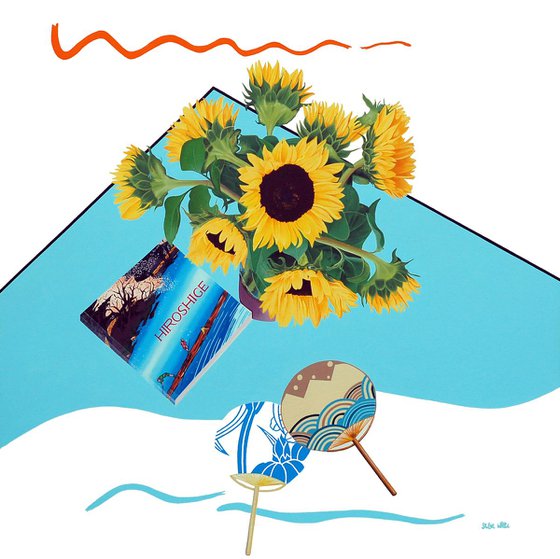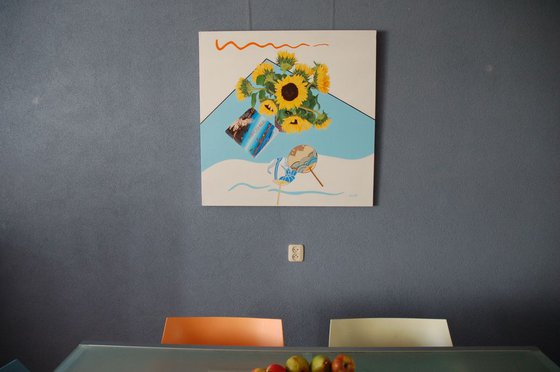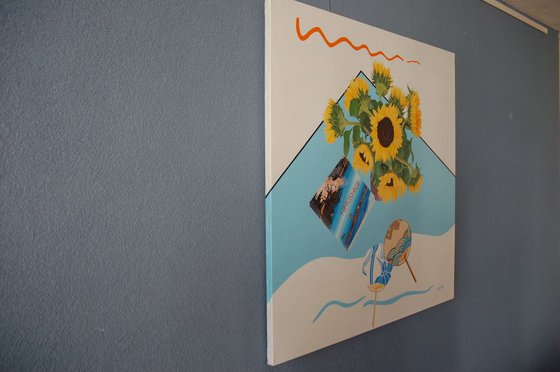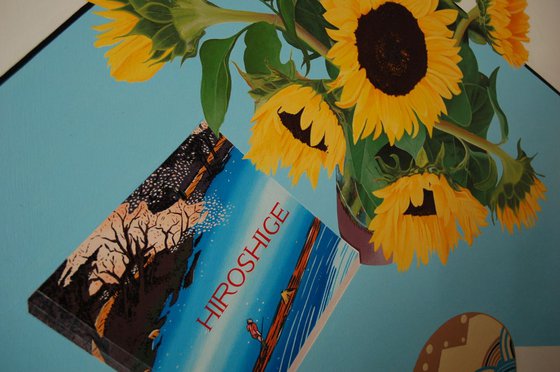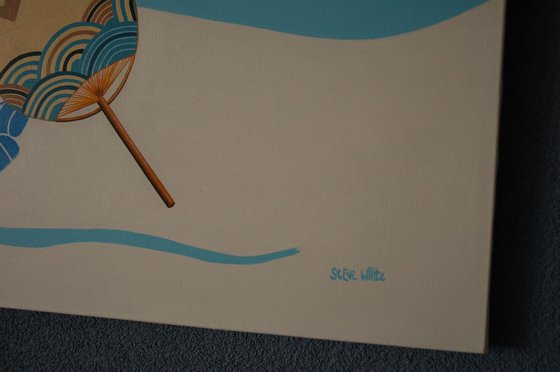- By medium
- By subject
- By budget
- Sales
- Gift cards
- Discover all art
- Artists
- Editors’ picks
- Ideas
Original artwork description:
For over 200 years (1641-1853) all foreign trade with Japan went through the Dutch trading post of Dejima, an artificial island in Nagasaki Bay. Dejima closed down in 1853, the year van Gogh was born. Apart from the ...er...unfortunate events in Indonesia during the 2nd World War, there has always been a good connection between Japan and the Netherlands. Indeed Vincent Van Gogh had a large collection of Japanese prints and was so enamoured with them that in one letter to his brother Theo, sent from from Arles in the south of France, he said 'all my work to some extent is based on Japanese art.' There are recent suggestions, by van Gogh specialist Martin Bailey, that his famous picture, 'Starry Night', painted when he was in the asylum in Provence, was inspired by the equally famous 'The Great Wave off Kanagawa' by celebrated woodblock artist, Katsushika Hokusai. Van Gogh also made two copies of artist Utagawa Hiroshige's work - The Flowering Plum Tree (1887) and The Bridge in the Rain (1887) (after Plum Park in Kameido and Sudden Shower over Shin-Ohashi bridge and Atake).
When van Gogh lived in Paris he painted 4 sunflower pictures - The Paris Sunflowers. In these pictures the sunflowers are shown flat on a table rather than in vases. When he moved to the Yellow House in Arles van Gogh wanted to decorate a guestroom with a series of twelve sunflower paintings in order to please Paul Gaugin who briefly came there to live. In another letter to Theo, van Gogh wrote, 'If I carry out this idea there will be a dozen panels. So the whole thing will be a symphony in blue and yellow. I am working at it every morning from sunrise on, for the flowers fade so quickly.' In Arles van Gogh painted 7 further sunflower paintings - none of which, incidentally, are called Sunflowers. (At the National Gallery once Margaret Thatcher asked to see van Gogh's 'chrysthanthemum' painting.) It would appear, however, that Gaugin didn't appreciate this generous decorative gesture very much. He and van Gogh didn't really get on and, even though Gaugin did paint one picture of van Gogh in Arles entitled ' The Painter of Sunflowers', Gaugin left Arles in a huff after a few months. During this time he may or may not have been responsible for the relocation of van Gogh's ear. After Gaugin left Arles van Gogh admitted himself into the Saint-Paul Asylum in Saint-Remy for a year, during which time he painted 142 paintings, including some of his most famous works. Barely two months after leaving Saint Remy it seems that van Gogh shot himself.
Why did van Gogh love sunflowers so much? Theories that he overindulged in absinthe and digitalis, substances which could have tinted what he saw with yellow, seem fanciful. The true answer could be more mundane: the south of France is Sunflower Central and van Gogh was among the first artists to use the vibrant yellow oil paints that were first made available early in the 19th century. Let' s face it sunflowers are a gift to artists. As the owner of a gallery once said to me 'yellow sells!'
I acquired this Hiroshige catalogue from the Royal Academy of Arts exhibition in London, in 1997, and often flick through it looking for inspiration. And then these sunflowers turned up in our house one day. Duh! Gift horse/mouth/don't look in it.
I painted this picture for your guest bedroom.
Materials used:
Acrylics
Tags:
#sunflowers #japan #van gogh #hiroshigeLand of the Rising Sunflower (2018) Acrylic painting
by Steve White
2 Artist Reviews
£729.79
- Acrylic painting on Canvas
- One of a kind artwork
- Size: 90 x 90 x 2cm (unframed) / 90 x 90cm (actual image size)
- Ready to hang
- Signed on the front
- Style: Photorealistic
- Subject: Still life
Loading
Original artwork description
For over 200 years (1641-1853) all foreign trade with Japan went through the Dutch trading post of Dejima, an artificial island in Nagasaki Bay. Dejima closed down in 1853, the year van Gogh was born. Apart from the ...er...unfortunate events in Indonesia during the 2nd World War, there has always been a good connection between Japan and the Netherlands. Indeed Vincent Van Gogh had a large collection of Japanese prints and was so enamoured with them that in one letter to his brother Theo, sent from from Arles in the south of France, he said 'all my work to some extent is based on Japanese art.' There are recent suggestions, by van Gogh specialist Martin Bailey, that his famous picture, 'Starry Night', painted when he was in the asylum in Provence, was inspired by the equally famous 'The Great Wave off Kanagawa' by celebrated woodblock artist, Katsushika Hokusai. Van Gogh also made two copies of artist Utagawa Hiroshige's work - The Flowering Plum Tree (1887) and The Bridge in the Rain (1887) (after Plum Park in Kameido and Sudden Shower over Shin-Ohashi bridge and Atake).
When van Gogh lived in Paris he painted 4 sunflower pictures - The Paris Sunflowers. In these pictures the sunflowers are shown flat on a table rather than in vases. When he moved to the Yellow House in Arles van Gogh wanted to decorate a guestroom with a series of twelve sunflower paintings in order to please Paul Gaugin who briefly came there to live. In another letter to Theo, van Gogh wrote, 'If I carry out this idea there will be a dozen panels. So the whole thing will be a symphony in blue and yellow. I am working at it every morning from sunrise on, for the flowers fade so quickly.' In Arles van Gogh painted 7 further sunflower paintings - none of which, incidentally, are called Sunflowers. (At the National Gallery once Margaret Thatcher asked to see van Gogh's 'chrysthanthemum' painting.) It would appear, however, that Gaugin didn't appreciate this generous decorative gesture very much. He and van Gogh didn't really get on and, even though Gaugin did paint one picture of van Gogh in Arles entitled ' The Painter of Sunflowers', Gaugin left Arles in a huff after a few months. During this time he may or may not have been responsible for the relocation of van Gogh's ear. After Gaugin left Arles van Gogh admitted himself into the Saint-Paul Asylum in Saint-Remy for a year, during which time he painted 142 paintings, including some of his most famous works. Barely two months after leaving Saint Remy it seems that van Gogh shot himself.
Why did van Gogh love sunflowers so much? Theories that he overindulged in absinthe and digitalis, substances which could have tinted what he saw with yellow, seem fanciful. The true answer could be more mundane: the south of France is Sunflower Central and van Gogh was among the first artists to use the vibrant yellow oil paints that were first made available early in the 19th century. Let' s face it sunflowers are a gift to artists. As the owner of a gallery once said to me 'yellow sells!'
I acquired this Hiroshige catalogue from the Royal Academy of Arts exhibition in London, in 1997, and often flick through it looking for inspiration. And then these sunflowers turned up in our house one day. Duh! Gift horse/mouth/don't look in it.
I painted this picture for your guest bedroom.
Materials used:
Acrylics
Tags:
#sunflowers #japan #van gogh #hiroshige14 day money back guaranteeLearn more
